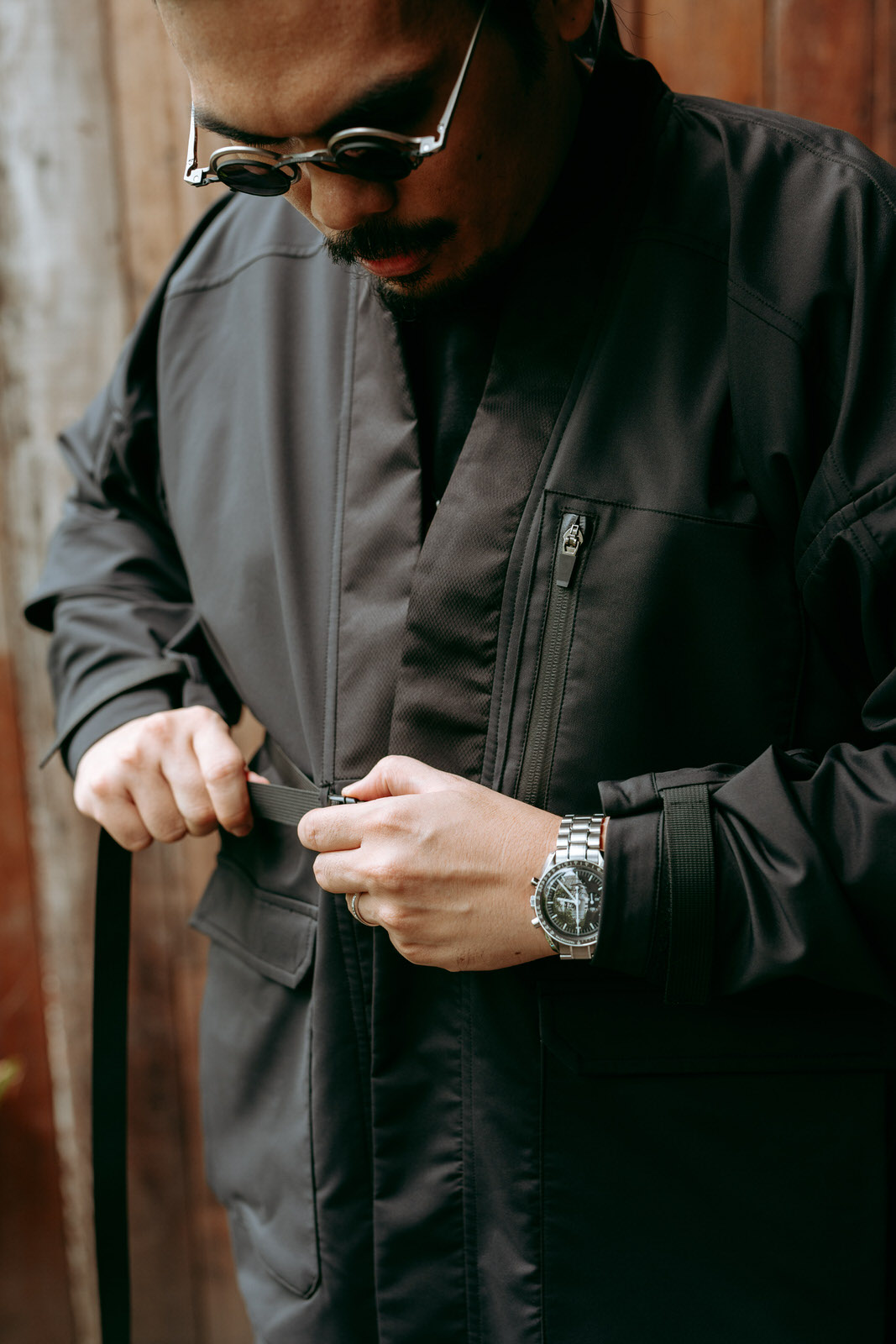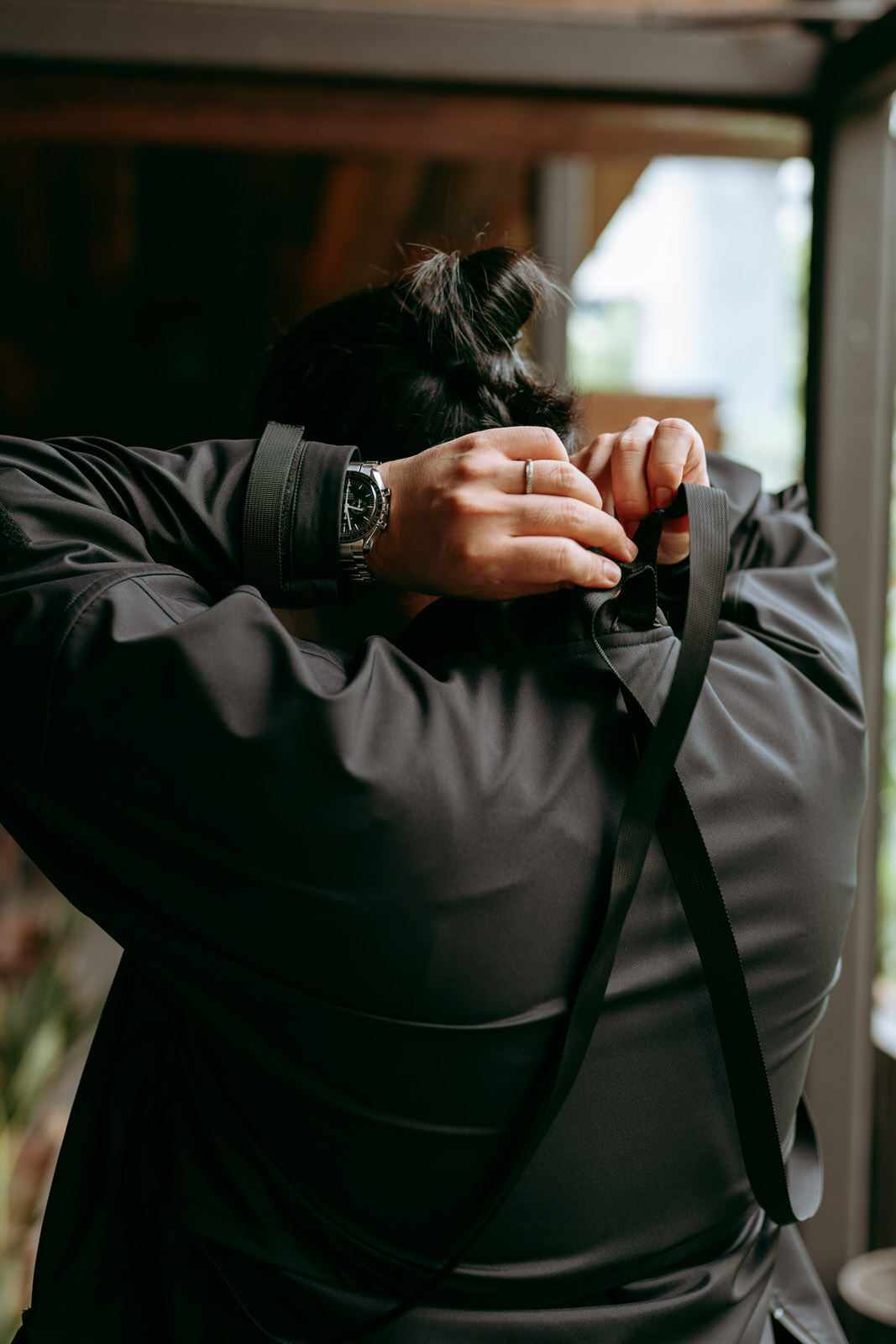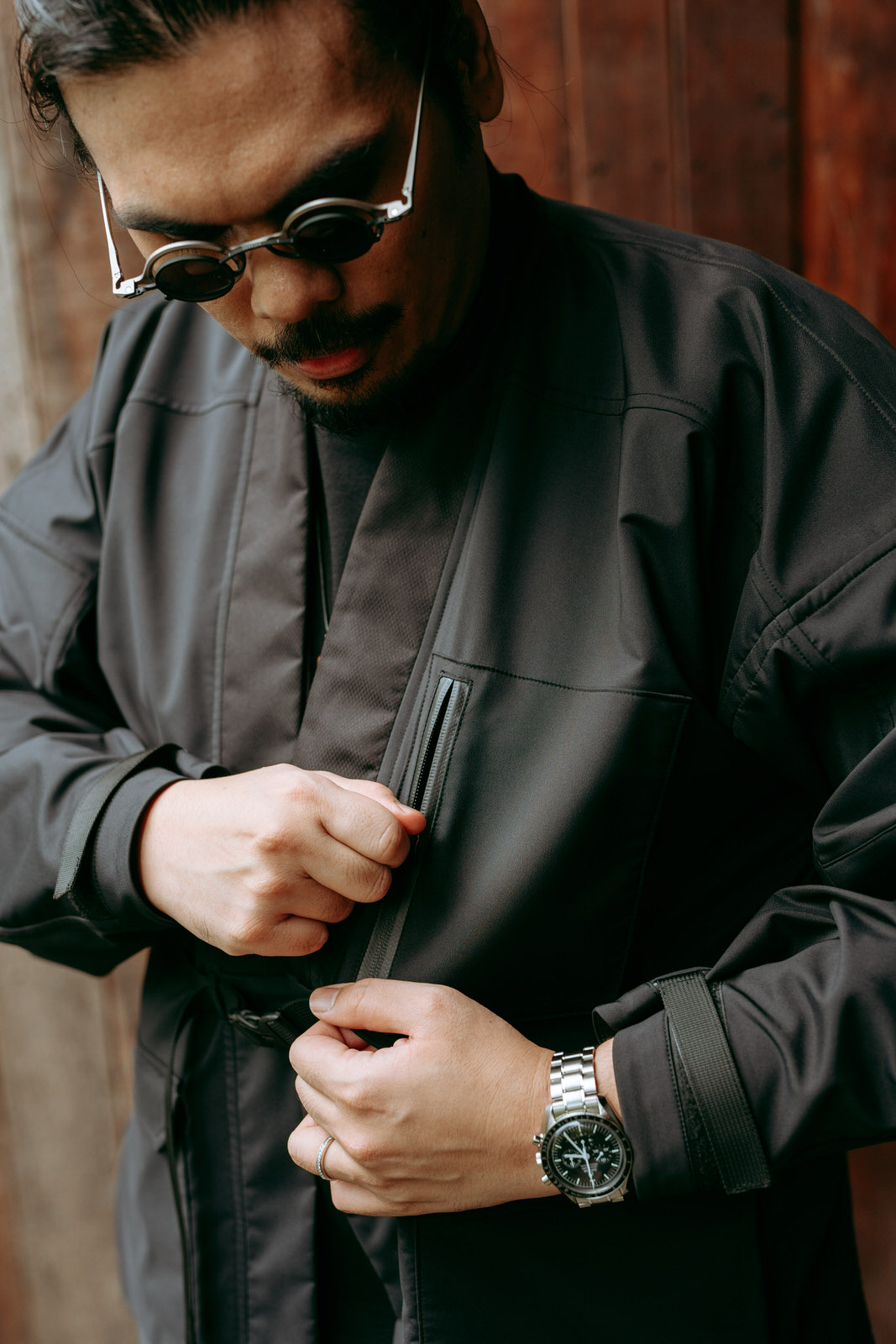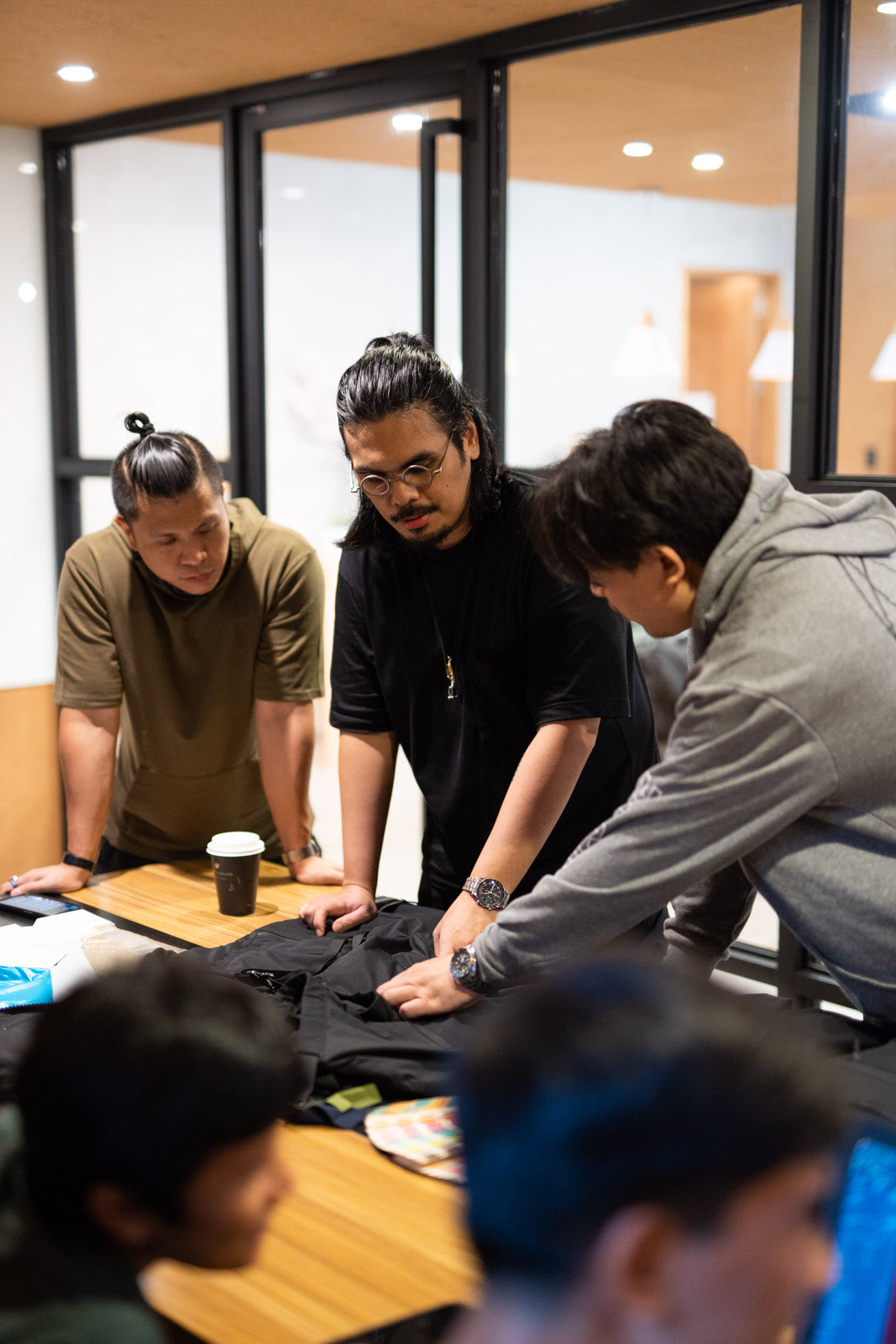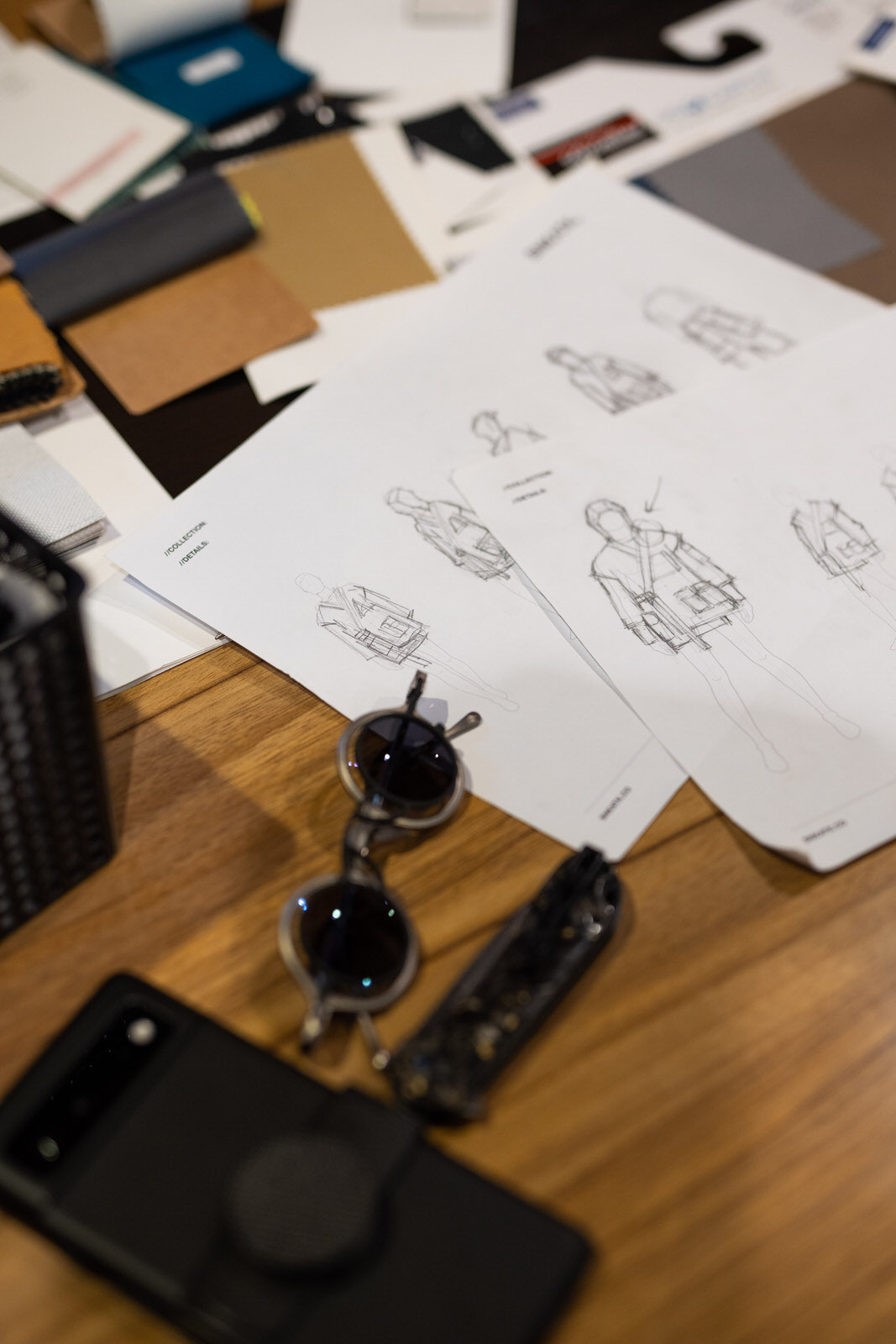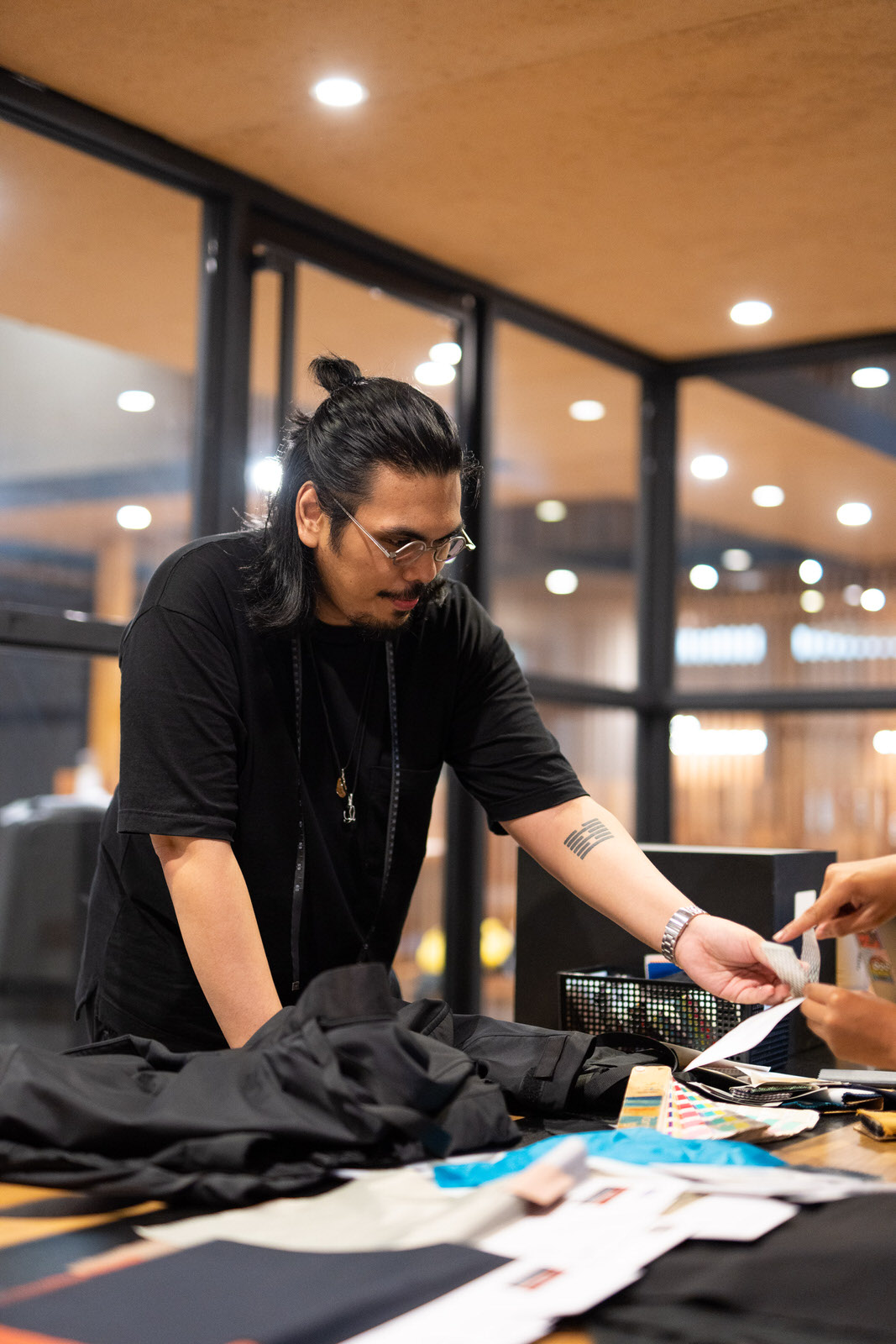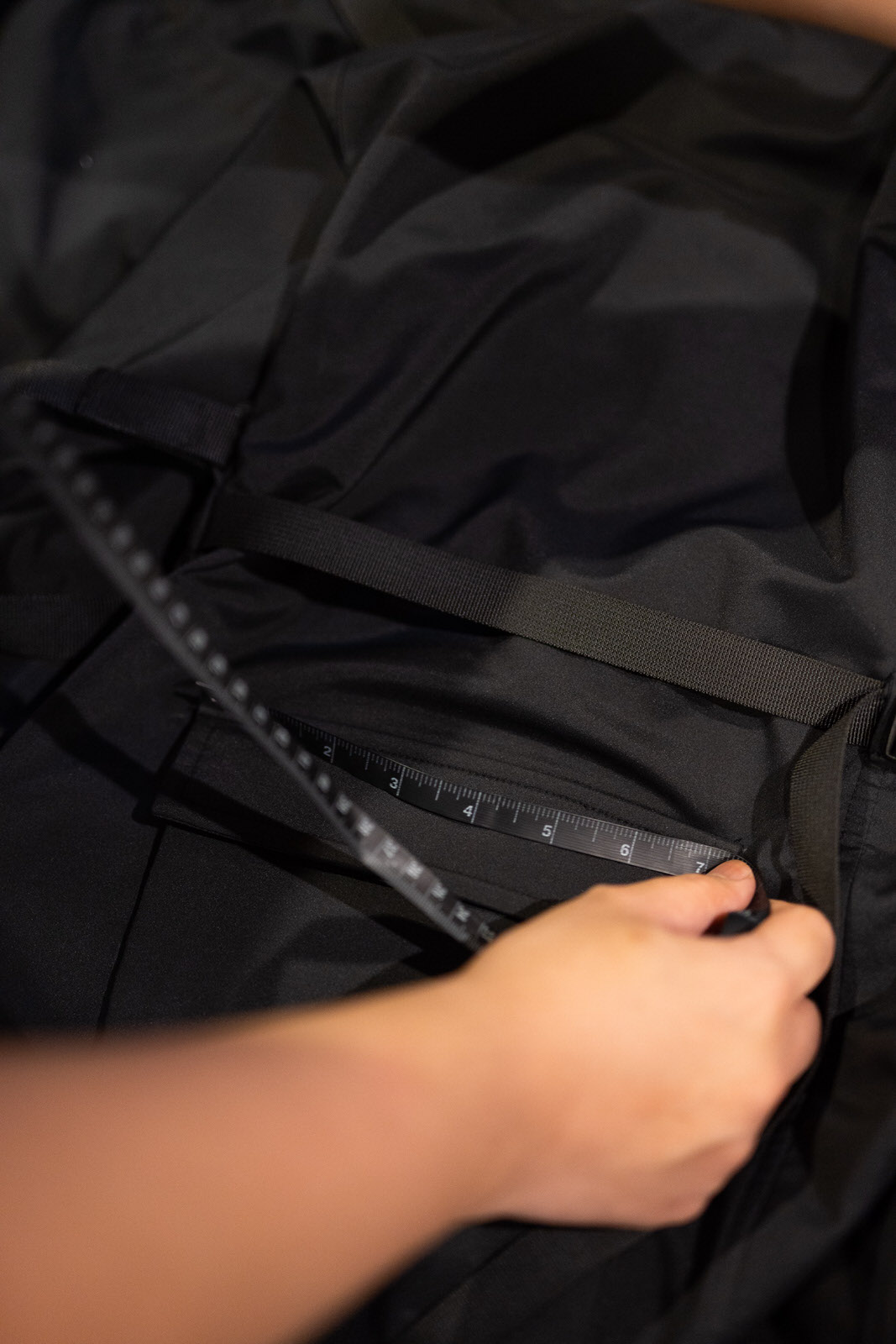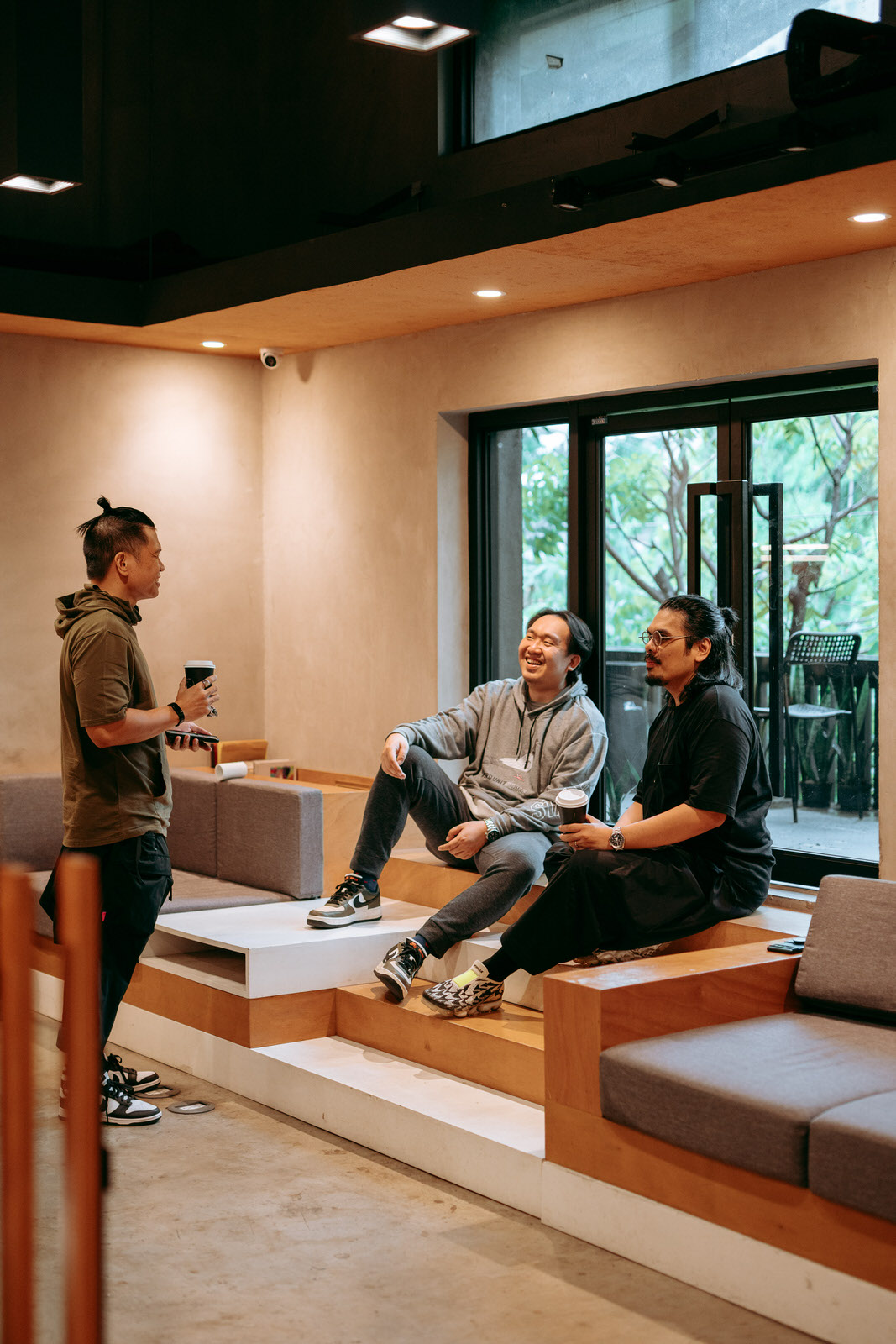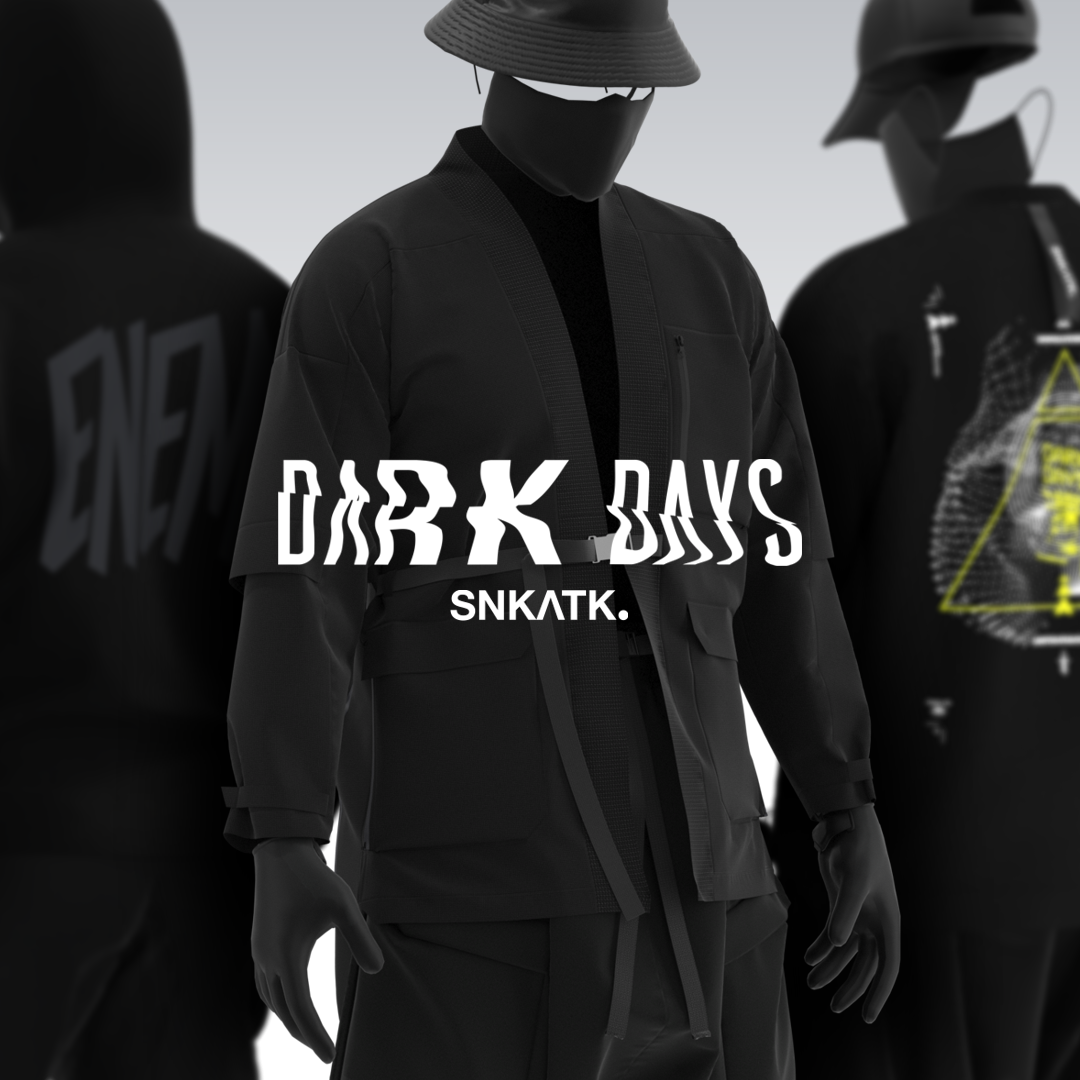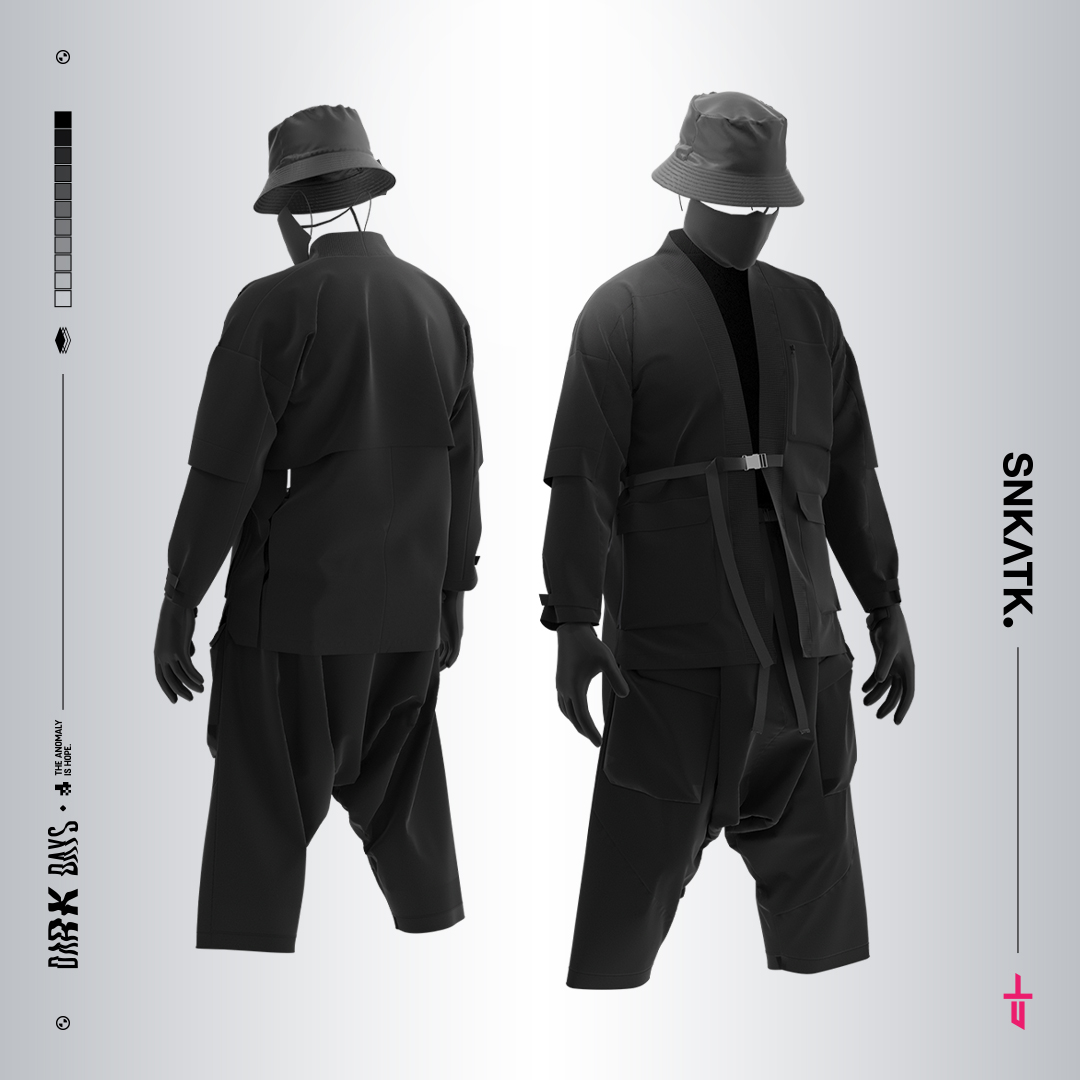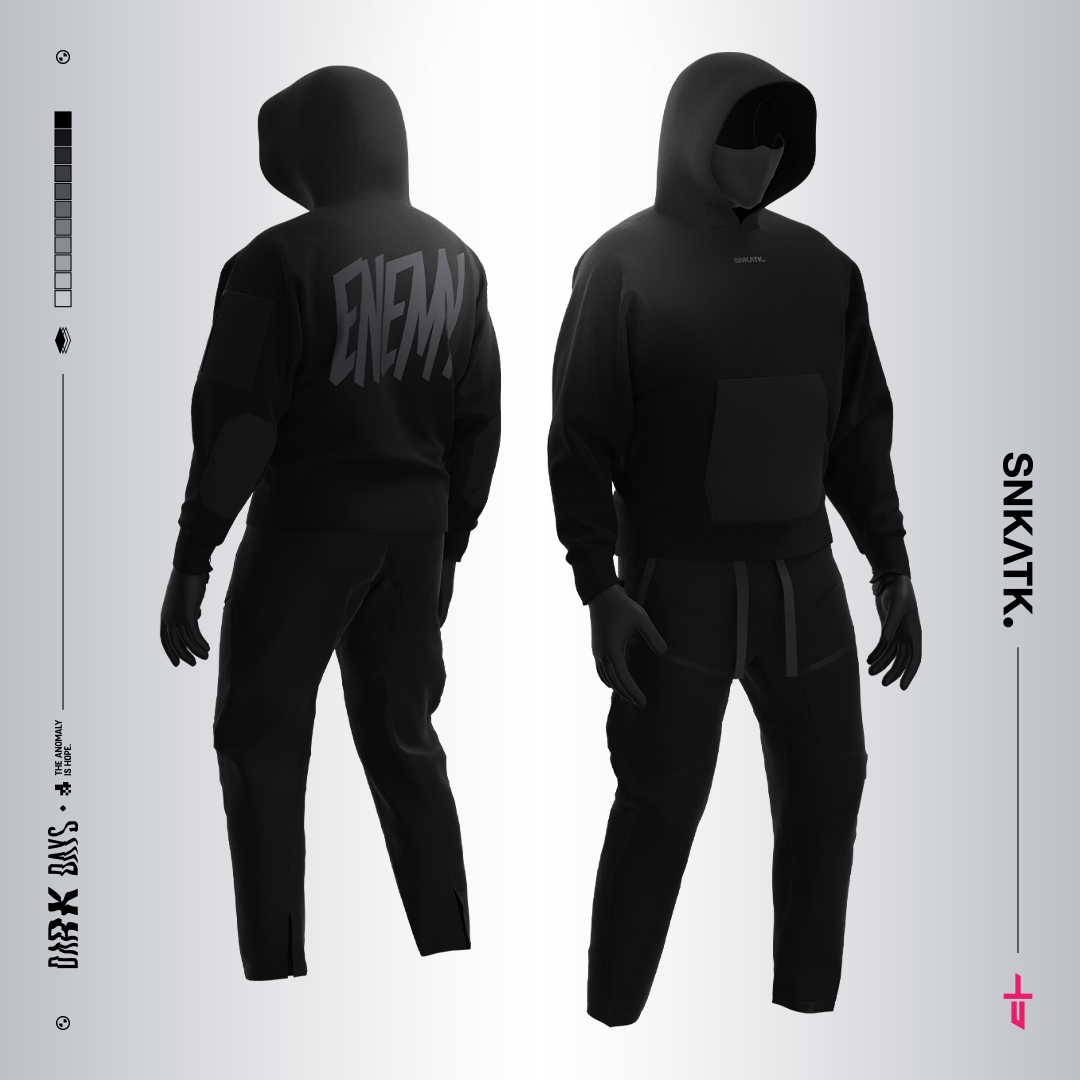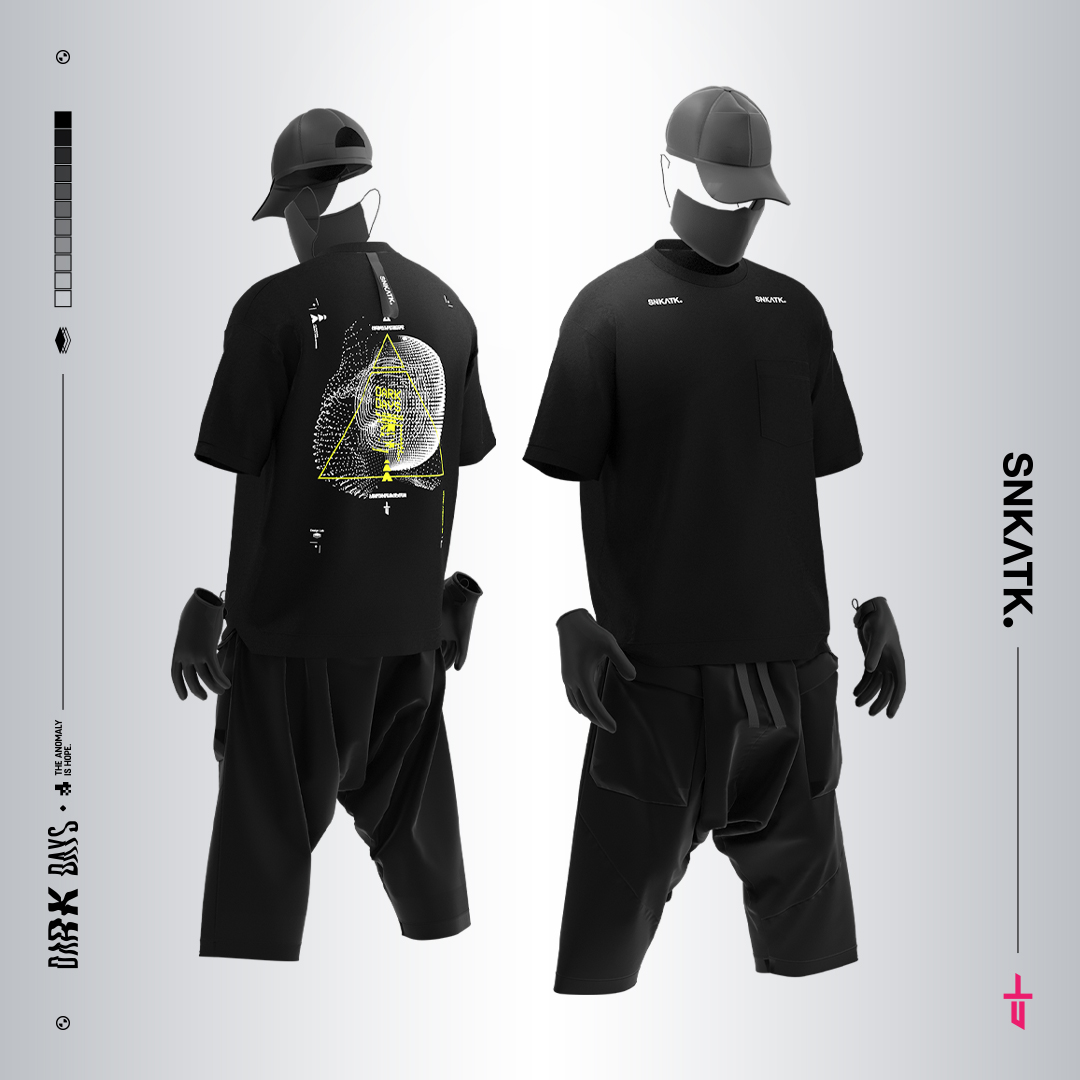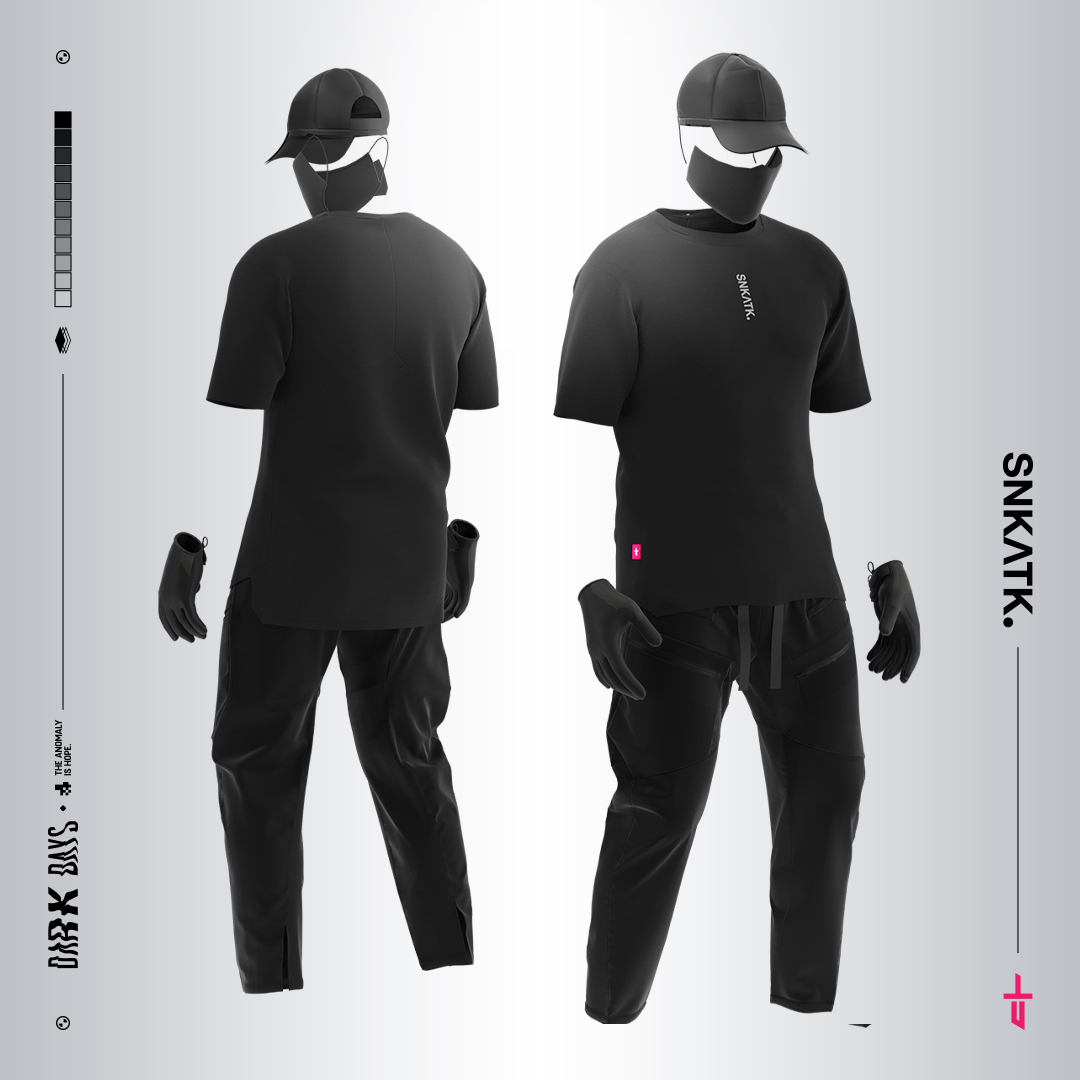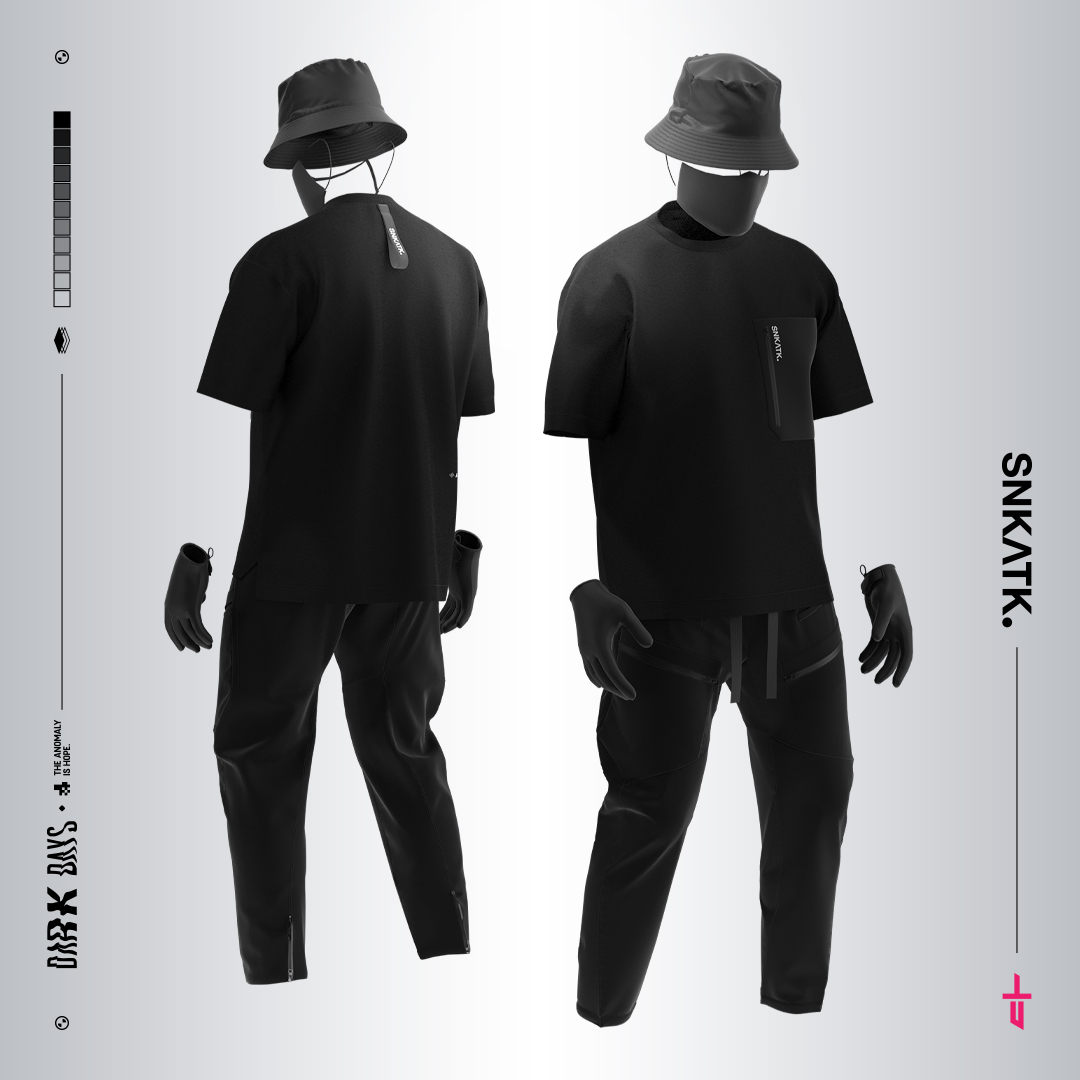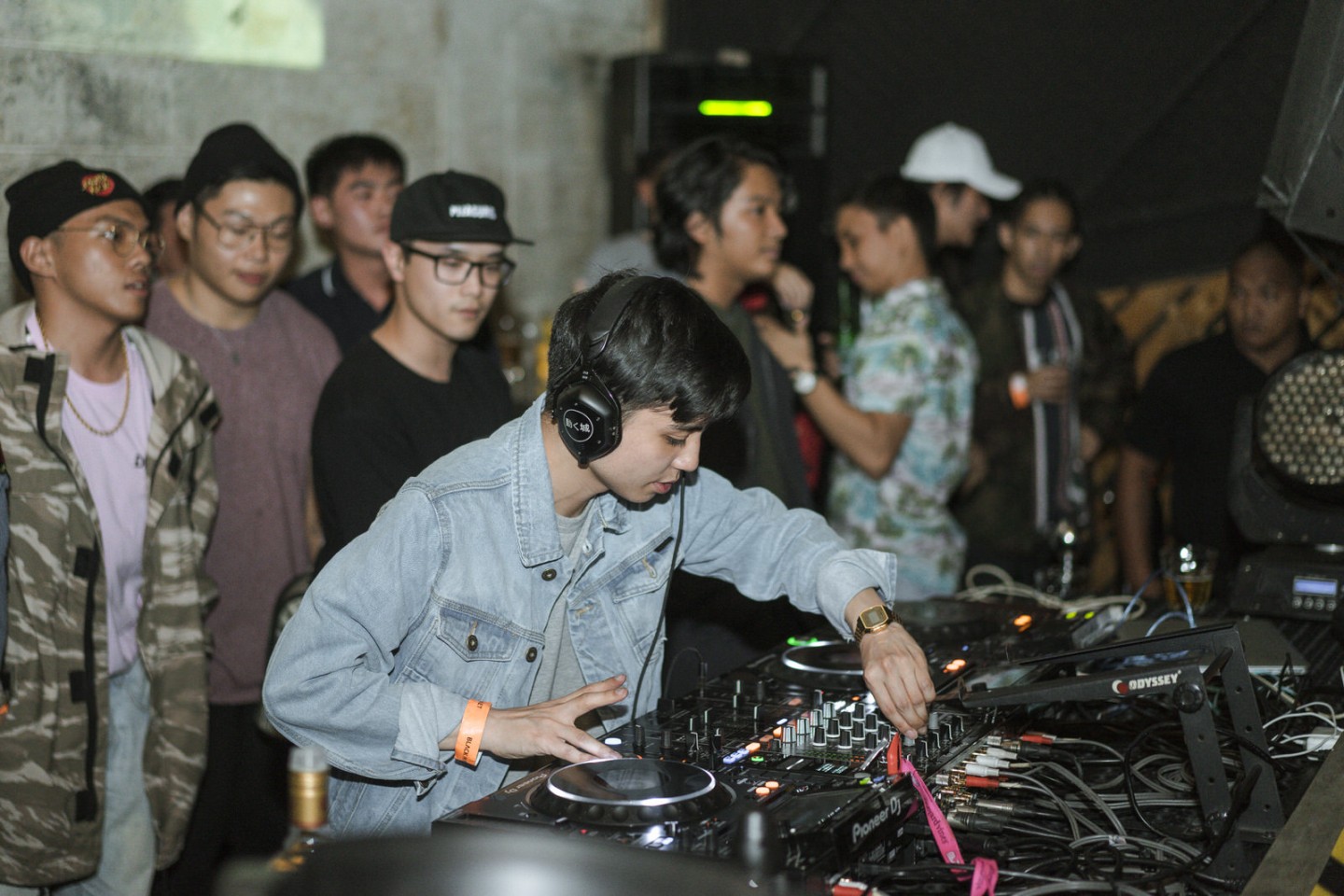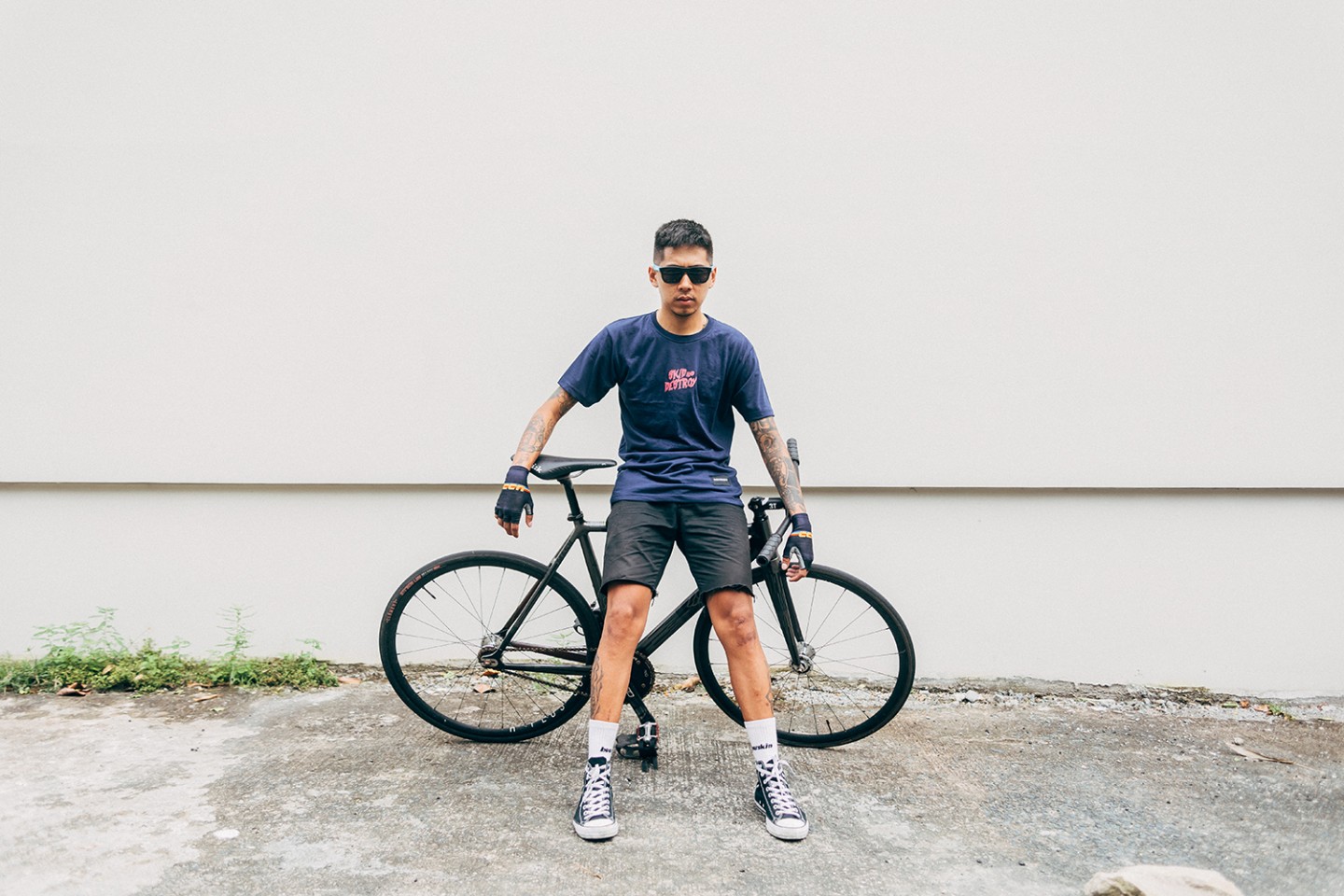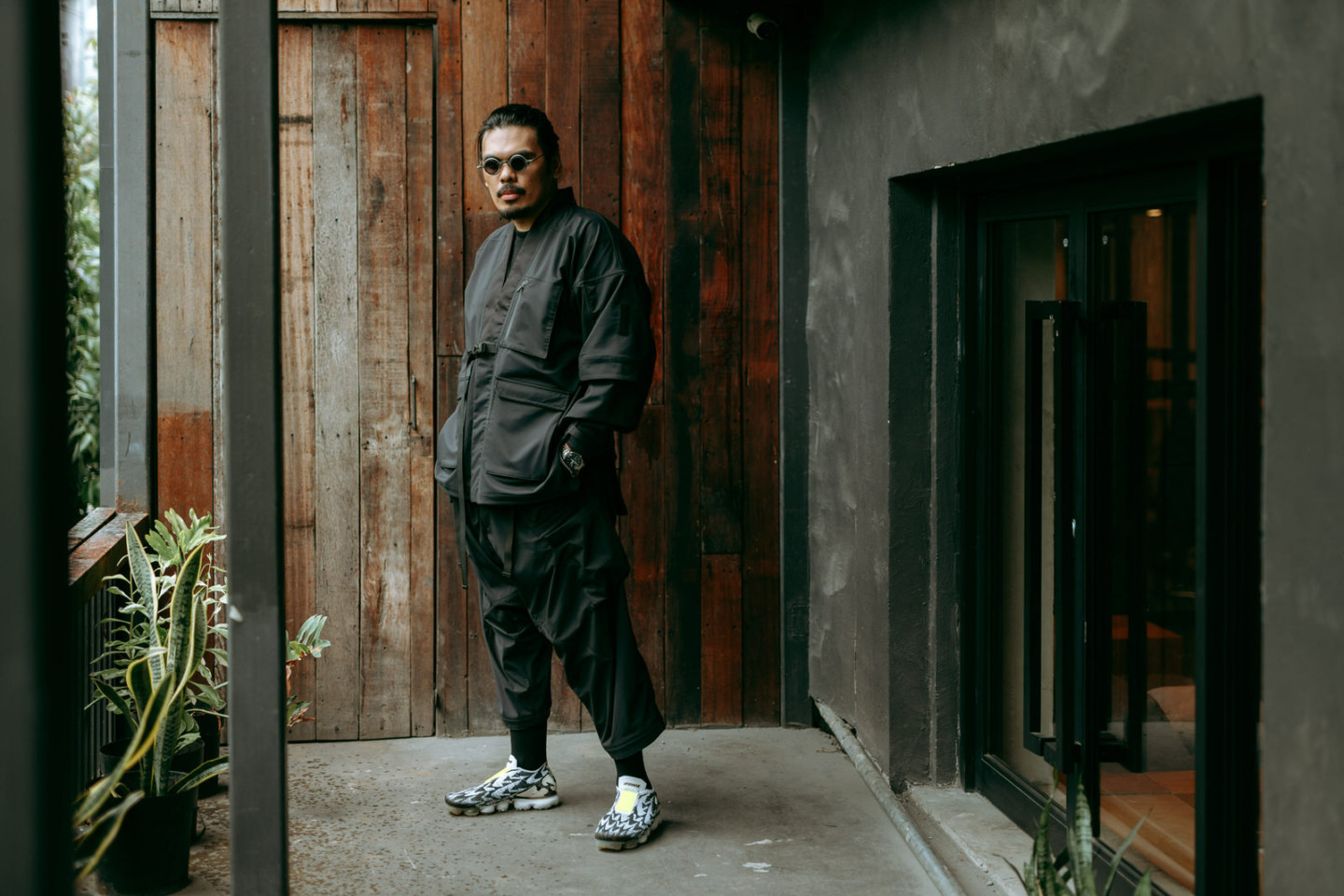
In the world of clothing, jargons are aplenty. Oftentimes, there are overlaps from different design disciplines, but one such area that SNK ATK focuses on is techwear. And one that they particularly embrace and excel in. We spoke with Co-Founder and Creative Director Psalm Alfafara on SNK ATK, techwear, going ‘phygital’, and their latest collection: Dark Days.
Tell us a little about SNK ATK.
While we’ve often been known for our techwear, I prefer to think of us as more of an experimental clothing brand, since you could get pigeon-holed to just being a ‘techwear brand.’
Before coming on to SNK ATK, I had a complex history with odd jobs, creative work, and business education. We can expand on that in a moment, but it was basically those experiences that helped cultivate that feeling of always feeling like an ‘other.’ From Davao, to Metro Manila, to the UK, and back—that’s a lifetime of changes and perspective shifts for one person.
It’s one megacomplex of transitory spaces, eras, elements through my experiences. I mean, it’s not all that I am, but it damn sure make up a big part of it. When I returned and started applying to design jobs back home, here in the Philippines, all of my experiences really shined through. I taught myself graphic design, web design, and ultimately learning what I could with the archaic tools at the time. I used to sneak into National Bookstore at Katipunan, at the second floor, specifically, where it was a total ghost-town, to read some of the available books to read on how to do it. Correl, Photoshop, Marketing, Graphic Design, where I could, when I could, and however I could.
A couple of websites, branding jobs, and logos for both local and foreign companies, and a whole transitory world of experiences on, and here I am. I hung out with a couple of creatives who I would eventually partner up with later on, and formed SNK ATK. A couple of other handles under my title, withstanding.
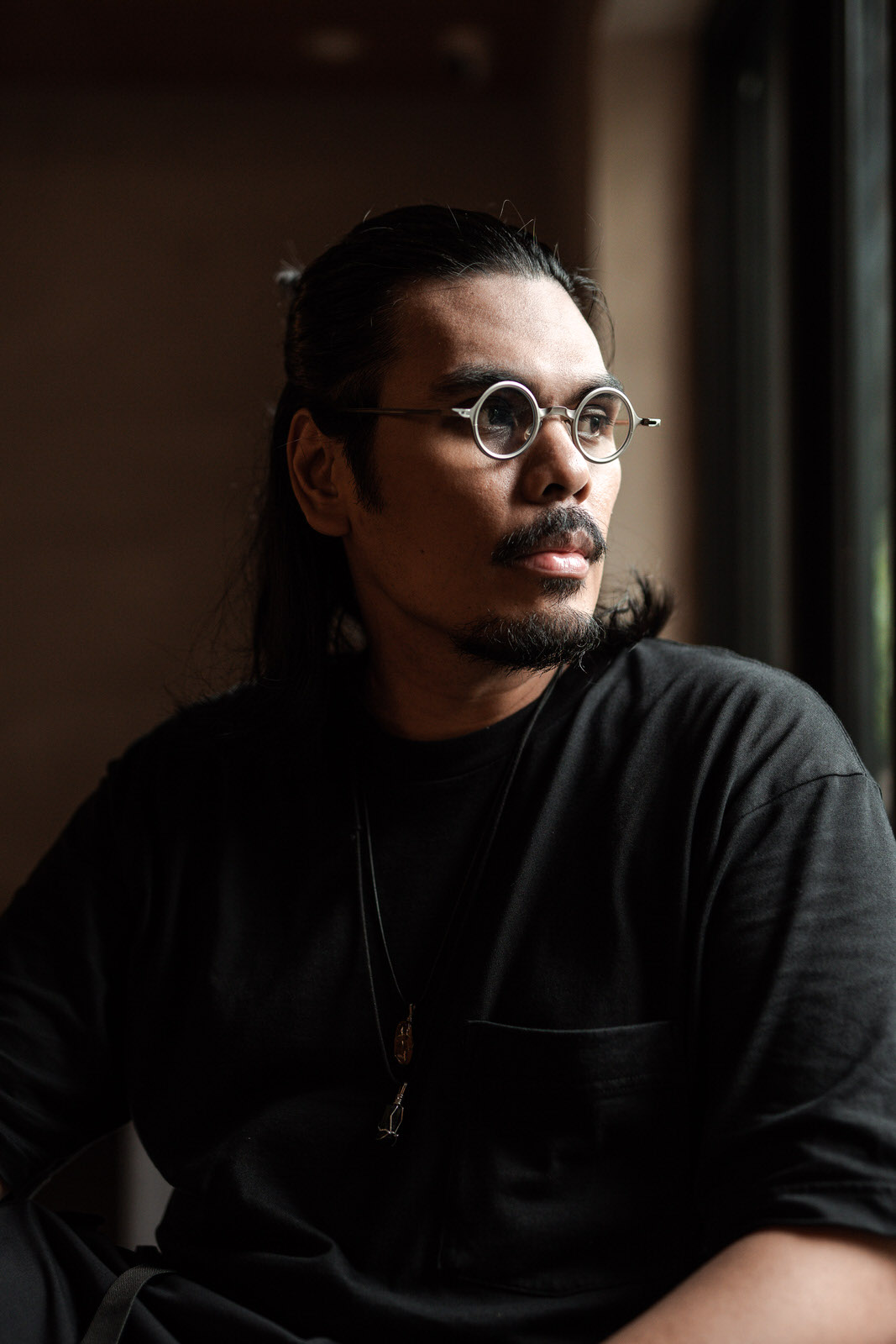
Photographer — Zaldine Alvaro
How did you come up with the concept of SNK ATK? What would you say is the central theme/concept for the designs and why distinguish that from techwear, itself?
Techwear is all about being slick and being efficient.
Something a lot of people get wrong about the design philosophy — and I don’t mean this as a monolith, that it’s unchanging and stagnant or anything — is that traditionally, it’s always been about solving problems neatly and efficiently. Something that commonly gets mistaken for it, warcore as an example, is being known for tactical rigs, packs, extra straps. Cyberpunk, which veers close and genuinely just looks pretty cool, skitters too closely with cosplay, which, again is very cool, but not exactly techwear.
We have to remember this, costumes are not always fashion trends. Costumes don’t always translate into the real world, and that’s especially true with fashion.
Haute-couture, avant-garde fashion, these are all practices that are available, but techwear doesn’t follow these same directions. For me, other fashion directions go heavily into the art, and of course whose artists those art come from, but when you’re primarily on design, sometimes the function takes a stronger presence than the art. That’s why I consider myself more a designer who tackles problems more than an artist who makes beautiful things. Customer has a problem, I offer a solution with design. But that’s not the same as saying that design can’t be art, because often times the design is art.
When we tackle techwear, it’s not just fashion; but fashion with purpose, the aesthetics coming on to serve the use and not only appearance. In a roundabout way, that’s why techwear has been so cut-and-dried to design around; its strength can become its weakness, because it’s so no-nonsense because it doesn’t maximize, its restraint can feel like a weakness.
What example can you give us of the subdued but intended functionalism of techwear?
Techwear, from its inception, borrows heavily from the cyberpunk roots that explore the mainstream ideal of the urban ninja, of cyberpunk dystopic fictions. Think Blade Runner, Akira, and the like, for some reference. The Noragi, a common worn staple in Japanese culture, is a frequent silhouette for many techwear items, but specifically peasant noragis are a functional product; they’re made from fabric scraps from their ancestors, elders, or even previous masters. A functional product of a resource issue, problem, solution—techwear in a nutshell.
Now, let’s go back to my own journey as someone making a living, designing on the fly, trying to get into circles. I grew up thinking I wanted to be an astronaut. Later on, I wanted to be a ninja, yet learning later on that ninjas didn’t even dress the way I thought they did. They were more like covert agents, disguising as individuals in their environment and with whatever fit the job, right? So, when coming back to those ideas while designing for SNK ATK, I would remember their design philosophy and apply that with my works: the slickness, the adaptability, the cultural notes, silhouette, and taste.
When the noragi was finalized as a key-piece, I saw a lot of myself in it. It was an infiltrator, an urban secretive purveyor, breaking out of many bubbles, and into a breakout industry—someone who dives through the world and rises above. My work with SNK ATK, and most notably Dark Days, I think really goes center into the idea that if you pull from the past, do it with reverence and respect, and make it work for the future.
Let’s veer out a bit and talk about Psalm Alfafara, the artist, and the times before. Can you touch more on your creative past, time in Davao and in the UK?
I’ve always strived to create beautiful things and enjoy the process along the way.
I’m not classically trained, even going so far as to call myself “a designer, twice removed.” In college, I pursued philosophy in UP, initially taking it because it was the only course that was available for me to take. I had an early-out start, right after graduating high school in an Ateneo school. As soon as I graduated, I left Davao because of how close-knit and same-y that upbringing felt. I never applied for any college there, and once in Metro Manila, the only one I applied to was UP Diliman, and that was the choice because taking Ateneo again in college would be too expensive.
One day, I saw that there was a summer exchange class to go to Oxford, and we (family) were finally in a safe-finance situation, I took it, went to the UK, met droves of people, a real diverse group, and then I saw that there was also an entrance exam for their business school. I thought, “Fuck it,” and took it, not really thinking much about it afterwards. Lo and behold, I get the acceptance letter to Oxford Business School. Dream come true, but funds weren’t unlimited. I knew I would still have to talk to my dad about this. Convincing him was tough, but at the end, the selling point really was pointing out the bragging rights: one member of the family is going to Oxford of all places. Additionally, my dad’s engineering work at the time added a lot of stability.
But it all had to come to an end, of course. ERAP (Former President Joseph Estrada) got ousted, and difficulties with family finance had started to arise. The freelancing wasn’t going to cut it, and my dad’s engineering contracts got pulled. I had to come back and start fresh, albeit starting with what I already know. Yeah, I got two years in Metro Manila, three-to-four in the UK, with a lot of life and job experiences. That initial shifting between worlds and learning new things on the fly were strengths, not weaknesses, though I hadn’t known at the time.
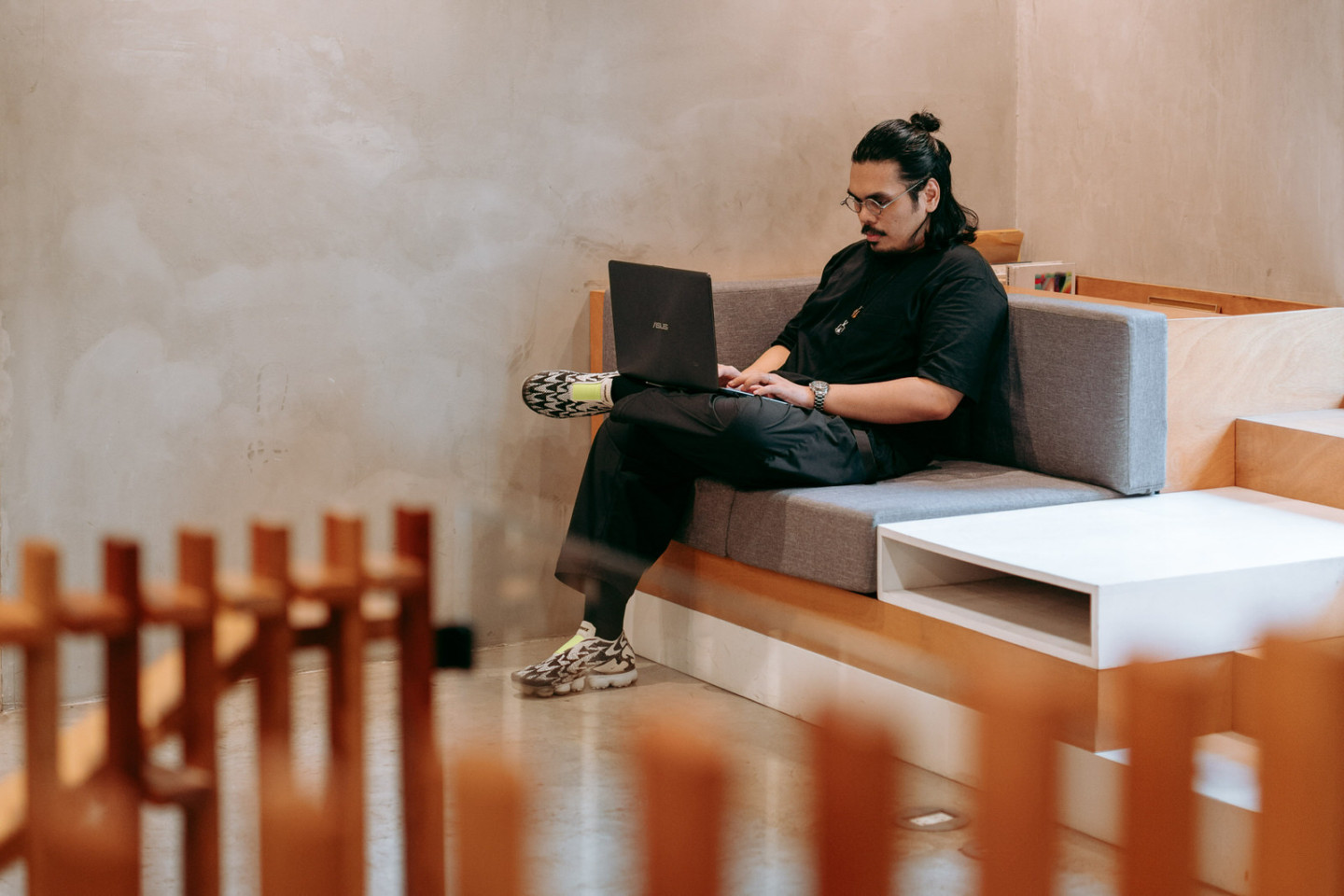
Before coming to Alfafara Design Co., SNK ATK, you’ve had an extensive history with different design groups. What made you decide to focus on singular projects as opposed under a corporation?
Corporations need creativity. Ironically, they don’t value them all that much in the corporate hierarchy. They’re looked at as content producers, designers, but they have little stake in the actual direction of the company. When you make things for them, but find that you’re not exercising your own creativity, really acting more like their mouthpiece than an independent voice, you can’t grow.
I’m reminded a little of Macchiaveli’s book The Prince. It wouldn’t make sense for power and goodness to go hand-in-hand all the time. When I think of my time in the corporate setting, especially with creativity and freedom of work, I think of how the book relayed how good gets taken advantage of, but where does that leave the good-doers? Same with creativity.
Here’s something: The Dilbert Principle states that management will often promote incompetent employees, sometimes onto management itself, to increase productivity, of course creating a vicious cycle of bad work getting validated and good work disappearing. Isn’t that messed up?
What is Dark Days about?
‘Here in this place, where darkness is the norm, the anomaly is hope.’
A bleak reality, endless upon endless obfuscation and obscured life, with brief touches on the Matrix, a very cyberpunk feel, lots of dystopian and neo-urban sci-fi touches of a world gone mad and technology way past the level of catching up. Dark Days is about feeling trapped, but knowing that there’s still something you can do about it. That in struggle, there is still light in the darkness and cracks in the wall.
The pandemic, to me and a lot of people, feels like this great paradigm shift. In work, people’s eyes have been opened, especially with remote work—a self-liberation even on small terms. People coming more and more to grips with working on their merits, not simply raising the wealth of someone else, and also being the captain of their own ships. Why would their presence have to be mandatory when technology can make up for it, anyway? And this was just one example of how control, of autonomy, of hope, being a key message for Dark Days. You’ve got the reins. You can do it.
How are liminal spaces important to the spirit of Dark Days, Part 1?
Dark Days, which is a two-part collection (Part 2 already in the works), is a response to what we’ve gone and went through in the pandemic.
Dark Days Part 1 is personal to me because there’s a lot of implicit storytelling that I injected into its release. The story is this: traveling through dark liminal spaces, eerie transitory areas that touch on weird parts of our brains. You ever go to abandoned theme parks, empty parking lots, warehouses and the like? And your brain goes, ‘Huh. Something’s going on here, but not really. Weird.’ And just stretched out. That’s a liminal space.
I grew up in Davao where abandoned areas were so rampant, and it was quite spread out. Where Metro Manila is dense, even back then Davao, as I remember, was like a sprawl. There’s a feeling I have so strongly when entering an old space that used to be a domestic space, a home for an example, and seeing all the emptiness. It’s not fear—like a fear of ghosts or unexpected shadows—but more like a longing with the sudden space between the walls. The closest I’ve found to labelling it is lost potential.
But on the other side of liminal spaces, and folks on Reddit can go on and on about endless hallways, the fear of monsters, or even hostile architecture all they want, but sometimes there’s the feeling of comfort in them. In all of the mystery, I imagine, there’s at least the small hope: ‘Oh, I know this. This is familiar.’
That’s what Dark Days, Part One especially, is trying to be all about, other than being a recalibration of the brand.
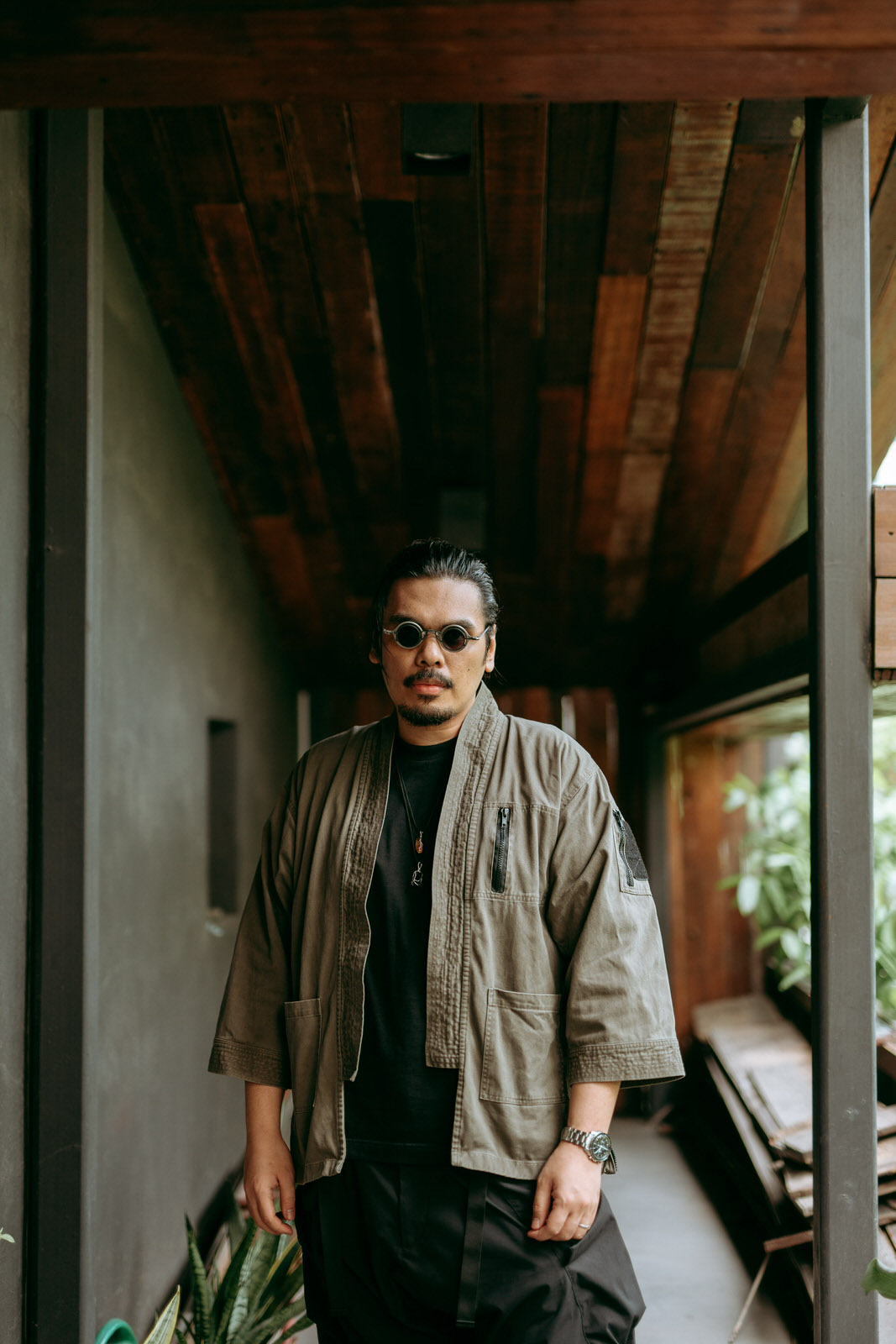
Can you talk a little bit about Dark Days foundational concepts: ‘Phygital’?
Phygital is physical-to-digital. It’s basically the result of the many sleepless nights that I taught myself fashion and clothing design, sewing where I could, when I could. I would sketch, make viewpoints in Illustrator, consult a tailor, all before finally testing it on a mannequin or putting the prototype on myself. It was very standard for most clothing designers, but it’s still quite a hefty process. And remember, it was at that this point too that I wasn’t fully integrated yet. I still considered myself an outsider. I didn’t have a tailor on hand, an atelier, a studio, so this was where digital design came from.
That’s what makes the entire process of this newest collection so exciting. This is the future. My colleagues tell me this is the first fully digitally designed collection in the Philippines, from patterns, to digital mock-up, complete with a ‘worn’ prototype, to eventual printing, and I’ll take that claim boldly.
Digital design lends so much strength to the process when you actually know what you’re doing: selective and hyper-specific value changes, real-time simulations of cloth, texture, fabric weight, and all without wasting a single pattern. And soon, with the rise of augmented-reality viewing tech, it would allow people to fully ‘see’ themselves wearing it, all through virtual space, before deciding for themselves.
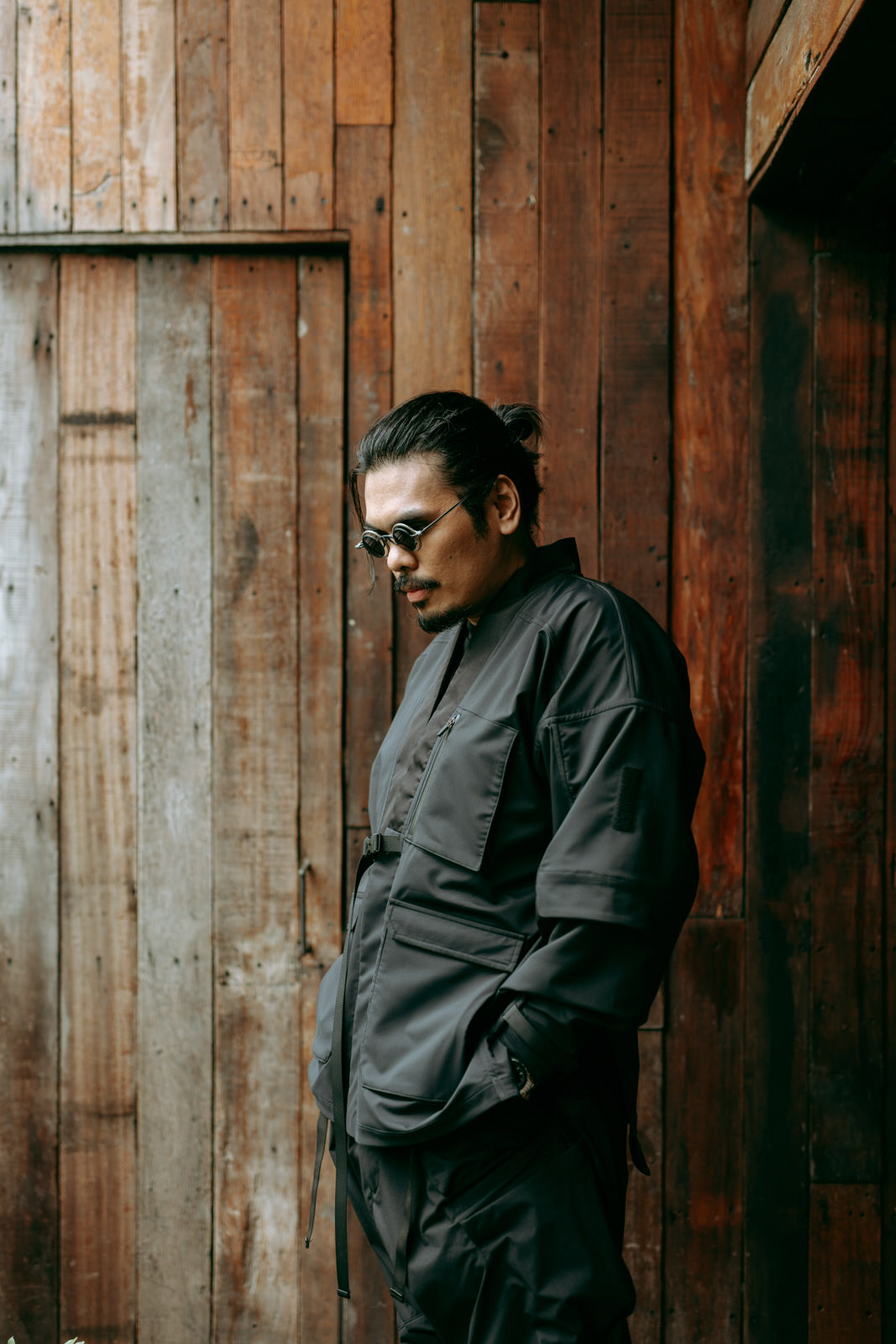
What sets the 3D process of SNK ATK’s collection apart from other boutiques with a similar idea in mind? How does the 3D process affect the collection?
When the pandemic hit, it was all so sudden that we just didn’t have the same resources at hand to get test fabrics, printings, silhouettes, like we planned before. All the shops were suddenly closed, there were no places to buy fabrics for technical clothing, and no one bought clothes that much since no one went out. For that year, we focused on collaborations to stay alive, and believe me, I love them, but it was a way of losing identity, especially for SNK ATK. With collaborations, you focus on budget constraints, branding constraints, so it works a lot like doing client work.
It’s a much better improvement, I think, than our current standard of pattern-making. I still have stark memories of coming to my seamstress, telling them what I want, and seeing the methods and resources as just lacking. There’s nothing wrong with working within your means, but when the industry as a whole is the bottleneck for why good creative work, and not just for Dark Days, can’t foster, you know there’s something wrong. Hopefully the next generation of designers can take from this example of digital design and make something amazing out of it.
For other creative designers looking to make something novel, something not seen before, what is the most important step?
Put emphasis on making something good. Don’t fuss over if it was done before, is new, or novel. First, always make it good. The rest will follow.
SUPPORT PURVEYR
If you like this story and would love to read more like it, we hope you can support us for as low as ₱100. This will help us continue what we do and feature more Filipinos who create. You can subscribe to the fund or send us a tip.

